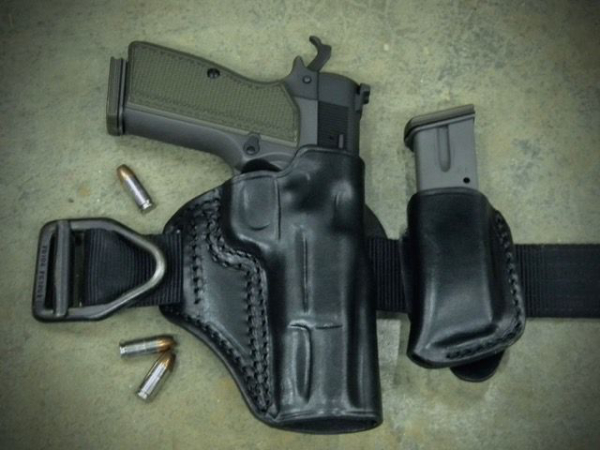Holster “cant” refers to the angle at which the holster rides on the body. Today, the vast majority of holsters are produced with a forward cant; traditionally called a F.B.I. cant. The pistol’s grip is forward with the muzzle tilted slightly to the rear. I spoke with Skip Ritchie of Ritchie Leather – who confirmed this. He said it’s rare for him to construct a holster without a cant. However, this wasn’t always the case. And, depending on body build and flexibility a straight-drop holster may work better than one that’s canted.

Originally holsters were made to hang straight. Think holsters of the “old west” for single action pistols. They were not “quick-draw” rigs. Retention was a major issue on the trail. Around 1920, Tom Threepersons collaborated with S.D. Myres to create a design that concentrated on allowing a quick, efficient presentation or draw. This design was improved by Charles Askins, Jr. for Border Patrol agents in the 1930’s and Bill Jordan, another Border Patrol Inspector. Holsters began to ride higher on the hip to make the pistol easier to conceal. They were worn slightly behind the hip, so a cant was added to make the pistol easier to draw. It was also more comfortable when seated, especially in a vehicle. F.B.I. agents carried concealed and wore these, as well as other variations of holsters based on the design, so it became known as the F.B.I. cant.
In “No Second Place Winner,” by Bill Jordan, he mentions experimenting with different cant holsters. Between various degrees of backward cant, straight and forwards cants he states that, “No appreciable difference in speed could be detected after practice with each.” The proper cant of the holster, again according to Jordan, should “clear the butt of the gun and the toe of the holster from the back of the car seat.” The drop or height of the holster should position the muzzle just above the seat – he advocated carrying a pistol with a four-inch or shorter barrel.
All of this makes perfect sense. After all, it’s coming from men who knew much more about gun fighting than any of us will. All of my holsters are canted, until now. My body has seen a hard life. Parts ‘n pieces don’t work as well as in the past, especially the shoulders. While the left side shoulder was reworked a few years ago the right, strong side shoulder has problems with mobility. Add this to the fact that the elbow and wrist are wonky and it makes drawing a pistol in a canted holster difficult.
The new Springfield SA-35 Hi Power provided me with a perfect reason to experiment. As mentioned above, I contacted Skip at Ritchie Leather to ask for his suggestions on a holster with a straight-drop. Yesterday’s mail included one of his “Vertical Speed Scabbard” holsters and a couple of mag pouches. As mentioned, I’ve never tried a straight-drop holster before, but now wish I had. This angle allows me to acquire a proper grip on the pistol without having to twist my wrist at an angle that’s very uncomfortable.
Sometimes, it takes a little experimenting to discover what works best for you. “Best” is also bound to change as we “mature.” Stay “young.” Be adventurous, always ready to explore, experimenting in search of that “best.” This keeps things entertaining and interesting, and may help you better prepare for potential problems.
Tiger McKee is director of Shootrite Firearms Academy. He is the author of The Book of Two Guns, AR-15 Skills and Drills, has a regular column in American Handgunner and makes some cool knives and custom revolvers. Visit Shootrite’s Facebook page for other details.